Buildings & Energy
In growing and improving our campus facilities, UofL is working to minimize environmental impacts and maximize opportunities for efficiency in our 177 buildings, (123 of which are on Belknap campus). Much of this effort is guided by the Office of University Planning, Design and Construction (UPDC). See a summary of UPDC sustainability efforts.
Building Dashboards
In 2012, UofL installed real-time energy-monitoring and display technology in four residence halls: Unitas Tower, Louisville Hall, Kurz Hall, and Community Park. These online Building Dashboards allow residents to get a handle on their energy usage and to get real-time feedback about conservation efforts within these residence halls.
Discover UofL's Model Green Rooms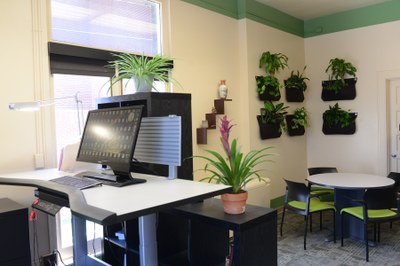
See a map of all UofL buildings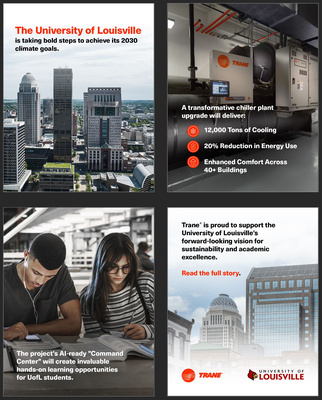 Trane and UofL kick-off modernization project to power a cooler, future-ready campus (Trane / UofL Sustainability News, Oct. 9, 2025)
Trane and UofL kick-off modernization project to power a cooler, future-ready campus (Trane / UofL Sustainability News, Oct. 9, 2025)
Our Building Dashboards help UofL residents gauge progress during our annual energy conservation competition and helped UofL finish in the top ten energy reducers in the spring 2012 Campus Conservation Nationals!
UofL's new LEED Gold Student Recreation Center opened in October 2013, featuring geothermal heating and cooling, solar hot water, rainwater capture & storage for irrigation, and a Siemens building dashboard available in the lobby on an interactive touch-screen that displays the performance of these systems.
Trustees extend energy-saving project (UofL Today, Feb. 6, 2015)
Workers to check for more energy savings (UofL Today, 7/2/14)
UofL featured in Carbon Disclosure Project webinar: Achieving Sustainability Through High Impact Energy Efficiency (9/4/13)

Energy & Water Efficiency
- UofL's annual utility bill (electric, gas, water, steam & chilled water) continues to grow. In FY2020 it amounted to $20.2 million and in FY2021, it was budgeted at $23.2 million. In essence, this means UofL spends nearly $2 million every month of the year on energy and water. These costs have nearly doubled in the past decade (in 2011, UofL spent $11.7 million on electricity and gas). There are tremendous cost savings and environmental benefits to be gained from using energy and water more efficiently on campus.
-
You can help us identify opportunities to save! If you notice problems in UofL buildings such as leaky plumbing fixtures, rooms that are excessively heated or air conditioned, windows that won't shut, lights which won't shut off, etc. take a moment to report the problem online hereor call it in:
Belknap Campus: (502) 852-6241
Health Sciences Center: (502) 852-5695
Shelby Campus: (502) 852-5601
- With $77M in new state funding in FY24 for Asset Preservation projects, UofL has been making massive new investments to renovate its existing facilities in order to increase the efficiency of our operations, reduce costs, consume less energy and water, and produce less pollution as a result. For details, see the UofL Asset Preservation (building and efficiency upgrades) YouTube Playlist. Some primary examples of these Asset Preservation projects include:
Belknap Central Chilled Water Plant
One of the signature projects underway 2025-27 is a comprehensive upgrade to the Belknap Central Chilled Water Plant. The upgraded plant will deliver up to 12,000 tons of cooling capacity, with more than a 20% reduction in projected energy consumption. A centerpiece of the modernization is a thermal energy storage (TES) system that features an approximately one-million-gallon chilled-water tank. This innovative system, sourced from a local manufacturer, will allow the university to produce and store cooling during off-peak hours and deploy it during peak summer demand. This will significantly reduce the run-time of chillers that must operate during the hottest periods, helping reduce strain on the electrical grid, and maximizing energy cost savings.The project is a pivotal component in UofL’s plan for achieving our Climate Action Plan goals for 2030.Natural Sciences Building
- Approximately 90,000 square feet of space, the renovation, which was completed in fall 2025, allowed it to continue being used.
- New boiler, high efficiency (98%) 1500 MBH for dehumidifying the building in early spring/late fall.
- New reheat chiller 72 tons, for dehumidifying the building in summer. It has a variable flow for increased efficiency.
- All new chilled and hot water piping to increase reliability.
- All new ductwork to increase fan efficiency and improve indoor air quality.
- All new LED lighting (52% better than code).
- New electrical switchgear with metering to measure building usage.
- Compete new roof, meeting modern efficiency requirements with insulation.
- New triple-pane windows, more efficient than code, with high Sound rating to minimize distractions from planes.
- New drinking fountains to minimize single-use water bottles.
- New corridor wall painting and flooring to brighten up the spaces.
- Six (6) New VAV air handling units, 84,500 cfm total
- High efficiency direct drive ECM fan arrays.
- No belts to service and no belt dust in airstream.
- High efficiency MERV 13 filters to remove dust from the air.
- CO2 outside air control.
- Designed for low water flow rates, 18-degree delta T, and low heating water temperature to improve heating efficiencies.
J.B. Speed School of Engineering Building- Approximately 30,000 square feet of new HVAC on floors 1,2, and 3 (Basement was previously renovated), which was completed in fall 2025.
- Removed all steam radiators and window air conditioners.
- New reheat chiller, 48 tons, for dehumidifying the building in summer. It has a variable flow for increased efficiency.
- All new chilled and hot water piping to increase reliability.
- All new ductwork to increase fan efficiency and improve indoor air quality.
- New electrical switchgear with metering to measure usage.
- Six (7) New VAV air handling units, 31,000 cfm total
- High efficiency direct drive fan arrays.
- No belts to service and no belt dust in airstream.
- High efficiency MERV 13 filters to remove dust from the air.
- CO2 outside air control.
- Designed for low water flow rates, 18-degree delta T, and low heating water temperature to improve heating efficiencies
2009-17 Energy Savings Performance Contract with Siemens
- During an earlier energy savings performance contract with Siemens, which stretched over three phases from 2009-2017, UofL made a $52 million investment in efficiency. The project involved upgrades to over 88 buildings (6.2 million square feet) on all three UofL campuses. These improvements were projected to directly save the university over $4.4 million every year and reduce our annual carbon dioxide emissions by over 46,000 tons (the equivalent of removing 7,690 cars from the road).
- With these improvements, UofL expects to reduce its utility bill by about $12,086 per day!
- These efforts produced documented results immediately. In FY 2011-12, for example, we documented that Belknap Campus alone reduced fuel use 48%, electricity use 27%, and water use 31%. Efficiency-minded campus users helped us exceed our engineers' expectations! They had predicted fuel use to decline nearly 40% and electricity use to drop at least 20% annually. Read more.
Some examples of efficient lighting and insulation jackets installed at UofL.
Low-flow shower head replacements were installed throughout Belknap campus in 2010.
Energy-saving project outpaces its goals (UofL Today, 1/28/13)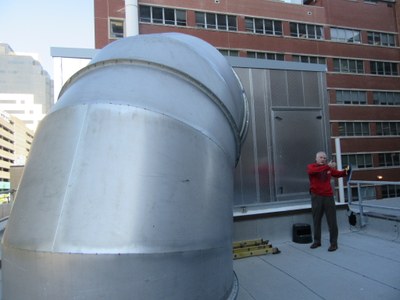
New High-Efficiency Air Handling Unit at Research Resources Center
- Examples of efficiency retrofits included:
- Efficient lighting: Installed 117,483 fluorescent lamps, 41,714 ballasts, and 1,729 exterior induction lamps. Reduces lighting energy consumption by 14% for an annual savings of over $915,000.
- Insulated steam valve jackets: 1,152 installed. Reduces heat loss at the valve by 90%. Saves over $327,000/year.
- Occupancy sensors for lighting: Installed 2,011 occupancy sensors to automatically shut off lights in vacant rooms. Reduces lighting energy consumption by 20-40%, saving over $97,000/year.
- Low-flow shower heads: 616 standard shower heads were replaced with efficient 2.0 gallon/minute heads. Reduces water use by an average of 11%, saving over $34,000/year.
- Low-flow faucet aerators: Installed 20,426 pressure independent aerators. Reduces water consumption at sinks by an average of 58% for an annual savings of over $159,000.
- Efficient motors: Replaced 259 motors with new models that use an average of 5% less energy for an annual savings of over $35,000.
- Energy efficient belts for motors: Replaced 213 standard V-style belts with non-slipping synchronous belts with variable frequency drives. Cuts energy use by an average of 8% for a savings of over $46,000/year.
- Learn more about the project and see pictures of the efficient technologies installed.
-
History of the Project:
- In October 2009, UofL and Siemens Building Technologies Inc. began work on a $21.7 million, 13½-year performance contract to increase efficiency on Belknap Campus.
- In 2010, a second phase performance contract was agreed for the Health Sciences Center, Shelby campus, and a few more Belknap projects, involving another $23.8 million in retrofits.
- On Feb. 5th, 2015, UofL trustees authorized spending up to $10 million more for a third phase of the contract. In June 2015, implementation work began on $5.4 million in improvements in lighting, heating, electrical systems, water conservation and other areas, expected to lead to another $457,600 in annual cost savings. Cardinal Sports Park, Ekstrom Library, J.B. Speed, Strickler, Shumaker, and Sackett halls on Belknap Campus were among the buildings that received improvements, along with the Research Tower and Baxter I, Baxter II and Medical-Dental research buildings at the Health Sciences Center. - Learn more about the project's cost savings, environmental benefits, and scheduling at our Energy Savings Performance Contract website.
Additional Investments in Efficiency:
- Beyond the performance contract, UofL continues to invest in energy efficiency improvements as opportunities arise. Projects include:
- In 2022, UofL won first place in the Region VII ASHRAE Technology Awards for the university's Belknap Academic Building in the new building – institutional education category. This award signifies successful and innovative building design focused on occupant comfort, indoor air quality and energy conservation. The LEED Gold building out-performed its own design in its first years of operation, performing at an Energy Use Intensity (EUI) of just 54.2 kBtu/sf/yr vs. its Designed EUI of 58 kBtu/sf/yr. Efficiency was at the forefront of the BAB's design, which used multiple energy efficient strategies such as energy recovery, dedicated outside air for first-stage cooling, a rooftop solar photovoltaic array, and dynamic glazing that adjusts tint level in response to the sun. The design team also worked collaboratively to ensure an efficient, tight building envelope. Collectively, these measures contributed to a significant reduction of HVAC system block loads. Read more.
- In 2021, UofL invested millions of dollars in a new, custom-built, high-efficiency air handling unit for the Research Resources Center at the Health Sciences Center. This investment in direct drive plenum fans not only reduced electricity use considerably over the old belt-driven system, but it increased the reliability and operability for a research-critical facility without having to take the building off-line.
- In 2018, UofL used a matching federal pedestrian transportation improvement grant to improve the quality and efficiency of outdoor lighting with LEDs installed along additional Belknap campus pathways, including the Humanities canopy lighting.
- In summer 2017, Campus Housing upgraded to new Energy Star washing machines and dryers that consume 40% less water and 25% less electricity than the original machines which are located in all UofL residence halls.
- In May 2017, UofL replaced lighting with high-efficiency, cooler, brighter LEDs in portions of the Baptist Campus Center, the lobby of the Playhouse, and in the dining area of the Ville Grill, where 240 42W bulbs were replaced with 26W LEDs. At the Ville Grill alone, this cut lighting energy use 38% for a savings of $1268/year (2.8 year payback) before even accounting for reduced load on HVAC.
Study shows campus energy project has paid off for region (UofL Today, June 2, 2015).
Watch video here. View photos here. Read full report here.
Belknap [Village North] receives LEED Gold certification (1/24/22)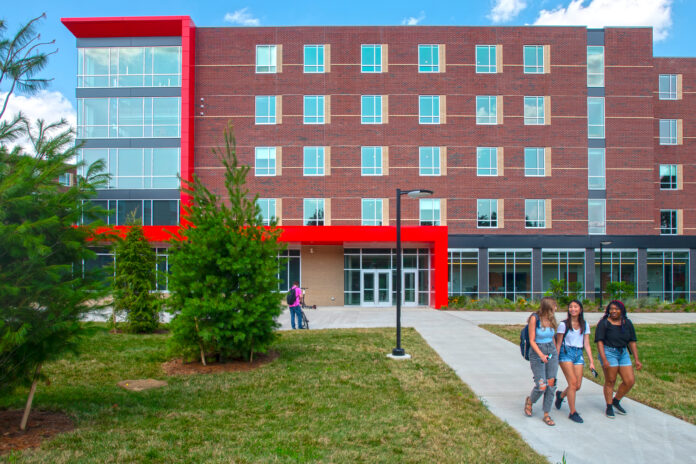
Belknap Villages use insulating concrete forms to increase efficiency and mitigate noise pollution
Center for Predictive Medicine, Shelby Campus
LEED Buildings
All new construction and major renovation projects at UofL are designed and built in accordance with Kentucky's High Performance Building Standards, using the Leadership in Energy and Environmental Design (LEED) Green Building Rating System™ as a guide or for certification, depending on the scale of the project. LEED standards not only encourage efficiency, but a wide range of practices which reduce the total environmental impact of buildings during construction and occupancy. UofL now has LEED Gold certified buildings on all three of our campuses!
UofL's ever-growing list of LEED projects includes the following. Click to learn more about the wide variety of green features we've incorporated into thesebuildings:
- Clinical & Translational Research Building, HSC (LEED Gold) - 2010, new construction, 287,970 sq ft, $136.3 million (scorecard, factsheet)
- Duthie Center for Engineering, Belknap (LEED Gold) - 2010, renovation, 35,000 sq ft, $5.8 million (photos. factsheet)
- Center for Predictive Medicine, Shelby (LEED Gold) - 2011, new construction, 9,870 sq ft, $35.2 million
- School of Dentistry, HSC (LEED Silver) - 2012, renovation & addition, 231,345 sq ft, $44.9 million (factsheet)
- School of Medicine (55B) MRI Imaging Suite, HSC (LEED Silver) - 2012, commercial interior renovation, 4,190 sq ft, $5.6 million (scorecard, factsheet)
- 600 North Hurstbourne, ShelbyHurst Research and Office Park (LEED certified) - 2012, new construction, 125,000 sq ft (UofL Foundation) (scorecard)
- College of Business Equine Industry Addition, Belknap (LEED Silver) - 2013, new construction, 7,255 sq ft, $3.4 million (scorecard)
-
Student Recreation Center, Belknap (LEED Gold) - 2014, new construction, 128,300 sq ft, $37.5 million (scorecard, factsheet, case study)
Case Study: Sports, Recreation & Sustainability - The New UofL Student Recreation Center © Omni Architects
- Nucleus Innovation Center, HSC (LEED Silver) - 2014, new construction, 197,720 sq ft, $37.5 million (UofL Foundation) (scorecard, factsheet)
- Lynn Soccer Stadium, Belknap (LEED Silver) - 2015, new construction, $18.5 million (scorecard)
- 700 North Hurstbourne, ShelbyHurst Research and Office Park (LEED certified) - 2015, new construction, 126,596 sq ft (UofL Foundation) (scorecard)
- 500 North Hurstbourne, ShelbyHurst Research and Office Park (LEED certified) - 2017, new construction, 119,810 sq ft (UofL Foundation) (scorecard)
-
Center for Predictive Medicine Addition, Shelby (LEED certified) - 2014 new construction, 13,000 sq ft, $9.9 million
- Ekstrom Library 1st floor east renovation, Belknap (LEED as guidance) - 2015 renovation, $2.25 million
- Ekstrom Library 3rd floor east renovation, Belknap (LEED as guidance) - 2017 renovation, $2.5 million
- ULAA’s Athletics Academic Building, Belknap (seeking LEED Silver) - new construction, $16.23 million
- Student Activities Center renovation, Belknap (LEED Silver) - 2018, renovation, 63,636 sq ft, $9.4 million
- Student Activities Center interior fit up, Belknap (LEED Silver) - 2018, renovation, 144,349 sq ft
- Student Activities Center east wing addition, Belknap (LEED Silver) - 2018, new construction, 32,969 sq ft
- Novak Center for Children’s Health, UofL Foundation, HSC (LEED Silver) - 2018, new construction, 174,000 sq ft, $50 million
- Belknap Academic Building, Belknap (LEED Gold) - 2018, new construction, 164,420 sq ft, $80.5 million (scorecard, factsheet, CMTA brief)
- Chi Omega House, Belknap (LEED as guidance) - 2018, renovation & addition (no UofL funding)
- 805 North Whittington Parkway, ShelbyHurst Research and Office Park (LEED Certified) - 2019, new construction, 144,078 sq ft (UofL Foundation) (scorecard)
- 435 North Whittington Parkway, ShelbyHurst Research and Office Park (LEED Silver) - 2021, new construction, 119,650 sq ft (UofL Foundation) (scorecard)
- Belknap Village North (LEED Gold) - 2021, new construction, 130,225 sq ft, $44 million (scorecard)
- Belknap Village South (seeking LEED Gold) - 2022, new construction, 130,225 sq ft, $43 million
- Engineering Student Success & Research Building (seeking LEED Gold) - 2025, new construction, 116,000 sq ft, $73 million
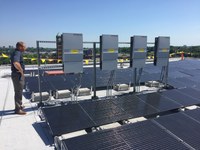 Powering UofL with Renewable Energy
Powering UofL with Renewable Energy
One of our goals in UofL's Climate Action Plan is to source 20% of the university's energy needs from renewable sources by 2020.
In 2020, we estimated that UofL is producing 3.67% of our energy from on-campus renewable energy systems. In 2017, the balance between energy consumption and production was as follows:
Total UofL energy consumption (excluding transportation): 761,205 MMBtu
Total renewable electricity generated on-site: 681 MMBtu
Total renewable non-electric energy generated on-site: 31,836 MMBtu
Renewable Energy
UofL contracts for over 15% of its electricity needs from new 125-megawatt solar facility planned for Kentucky (UofL Sustainability News, Oct. 14, 2021)
University of Louisville is on its way to carbon neutrality (Louisville Alternative Energy Examiner, January 31, 2012)
- The sun shines bright on our old Kentucky home!! As we transition toward climate neutrality by 2050, UofL has made a bold commitment to renewable energy. Our first benchmark goal was to source at least 20% of our power from renewable energy sources by 2020. We have yet to achieve that goal. In 2021, we thought we were getting back on track to do so by 2025, once the ink dried on a long-term contract with LG&E for approximately 10MW of solar power from a new facility that was to be built in western Kentucky. This contract alone would have supplied about 15% of our total energy needs. Unfortunately, two and a half years later, LG&E decided to terminate the original contract on us before a single solar panel went up, and presented revised terms that increased the costs to the university by 36 times! The university continues to seek out affordable means of achieving our renewable energy goals.
- UofL has been exploring all renewable options including solar, biomass, geothermal, and low-impact hydropower projects. Some of these efforts are tied to educational and research objectives at UofL. More details are available in UofL's Climate Action Plan.
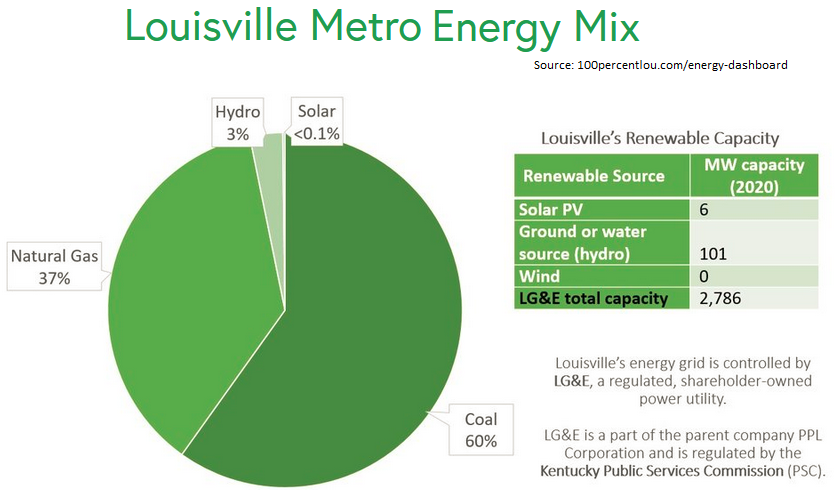
- At the moment, UofL, like most utility customers in Kentucky, still relies largely on fossil fuel-generated power purchased from the grid. We do not currently generate a significant percentage of our electricity on campus, but we are moving in that direction with a commitment to renewable energy that has already manifest itself in a number of pilot projects. In 2020, these added up to a total of 3.67% of UofL's energy needs served by renewables (excluding vehicle fuels).
- In solar energy alone, UofL has installed on campus a total (as of 2024) of: 589 photovoltaic panels (143.4 kW) and 35 solar thermal collectors (120.16 square meters).
-
 In December of 2023, UofL broke ground on the Engineering Student Success & Research Building at the Speed School, which opened fall 2025 with classrooms, labs, offices (including the Conn Center for Renewable Energy Research), and club workshops and maker-space. The 114,000 square foot building on 1 acre of former parking lot cost $90M to construct and about $1.4M/year to operate. It is was designed to achieve at least LEED Gold and features many energy efficiency and renewable energy systems, including the university's second geothermal system to provide baseload heating and cooling using 160 wells drilled to 600’ deep. A lower south flat roof was constructed as "solar-ready" to potentially house an 80kW photovoltaic system (when sufficient funds can be raised). Fundraising is also under way to potentially add other renewable energy systems, such hydrogen fuel cells, which hold the potential to make this UofL's first net-zero energy and LEED Platinum building! The building is also UofL's first to be intentionally designed to educate, providing users with real-time information about energy systems and revealing sustainability features to the public. Some building systems will be intentionally exposed to offer "engineering on display" and a large dashboard in the main atrium will include information about the sustainability features and energy production and usage. If funding is secured to install the solar PV array, it will be the first solar system installed at UofL that is visible (from both the ground and from inside the building). Learn more and support the project here.
In December of 2023, UofL broke ground on the Engineering Student Success & Research Building at the Speed School, which opened fall 2025 with classrooms, labs, offices (including the Conn Center for Renewable Energy Research), and club workshops and maker-space. The 114,000 square foot building on 1 acre of former parking lot cost $90M to construct and about $1.4M/year to operate. It is was designed to achieve at least LEED Gold and features many energy efficiency and renewable energy systems, including the university's second geothermal system to provide baseload heating and cooling using 160 wells drilled to 600’ deep. A lower south flat roof was constructed as "solar-ready" to potentially house an 80kW photovoltaic system (when sufficient funds can be raised). Fundraising is also under way to potentially add other renewable energy systems, such hydrogen fuel cells, which hold the potential to make this UofL's first net-zero energy and LEED Platinum building! The building is also UofL's first to be intentionally designed to educate, providing users with real-time information about energy systems and revealing sustainability features to the public. Some building systems will be intentionally exposed to offer "engineering on display" and a large dashboard in the main atrium will include information about the sustainability features and energy production and usage. If funding is secured to install the solar PV array, it will be the first solar system installed at UofL that is visible (from both the ground and from inside the building). Learn more and support the project here. - T
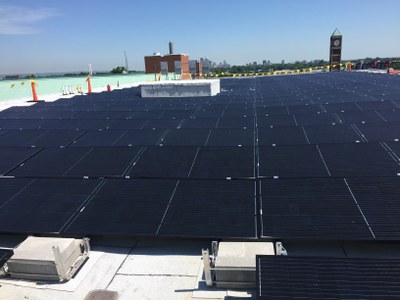 he 170,000 sq ft Belknap Academic Building opened in 2018 with a photovoltaic solar system on the penthouse roof which supplies 5.1% of the total energy needs of the building. With 321 panels, it is an 89 kW system with an estimated annual production of 115,709 kWh.
he 170,000 sq ft Belknap Academic Building opened in 2018 with a photovoltaic solar system on the penthouse roof which supplies 5.1% of the total energy needs of the building. With 321 panels, it is an 89 kW system with an estimated annual production of 115,709 kWh.
- In spring 2014, UofL installed a 16-panel, 165 MMBtu solar pool heating system on the roof of the Ralph Wright Natatorium to tackle the high energy demands of regulating the temperature of the largest body of water on campus - our Olympic-size pool!
- UofL's LEED Gold Student Recreation Center opened in October 2013, featuring not only a 134 MMBtu solar hot water system, but 128,000 square feet of space heated and cooled by the University's first geothermal system. The geothermal heat pipe is a closed-loop vertical well system with a total of 180 wells drilled to a depth of 400 feet.
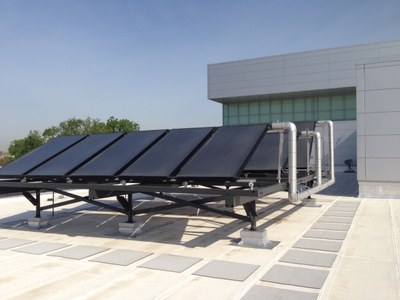 This 4960 MMBtu system provides ample reserve capacity and is expected to generate about 22% annual energy cost savings compared to a conventional system. It is also considerably simpler and cheaper to maintain. Occupational use of the new facility has tripled when compared to the previous Recreational Center, yet energy costs were reduced to provide UofL with almost $100,000 of savings per year. See case study. Read more.
This 4960 MMBtu system provides ample reserve capacity and is expected to generate about 22% annual energy cost savings compared to a conventional system. It is also considerably simpler and cheaper to maintain. Occupational use of the new facility has tripled when compared to the previous Recreational Center, yet energy costs were reduced to provide UofL with almost $100,000 of savings per year. See case study. Read more.
-
Engineering team from UofL to compete in international solar decathlon (UofL News, April 6, 2021)
Learn about UofL's Phoenix House:
- Solar-powered house gets new life at Speed School (UofL News, May 16, 2016) Video.
This tiny house is a 'living lab' for big tech (Louisville Business First, May 12, 2016)
Super geeky house takes on new UofL role (Courier-Journal, May 10, 2016)
- Team Kentuckiana - The Phoenix House
- Students welcome hundreds to see inside solar house. Photos.In October 2013, UofL students took part in the U.S. Department of Energy's Solar Decathlon competition, finishing first in the Affordability and Power categories! Read more about the experience.See the full results here. UofL students, faculty and staff collaborated with others from Ball State University and the University of Kentucky as Team Kentuckiana to design and build a fully solar-powered, modular home called "The Phoenix House." The project was designed to aid in disaster recovery and provide a model of green living!
- In Spring 2016, the Phoenix House was reinstalled at UofL (at the southeast corner of Ernst Hall) for further research and educational purposes, and to act as administrative offices for UofL's Conn Center for Renewable Energy Research. This energy-efficient, solar-powered (6 kW array of 27 PV panels on the roof with lithium ion battery storage) building is using the campus as a living lab for sustainability, testing smart net metering and energy storage technologies. In addition to modeling the future of energy, it features native plants grown in UofL's own compost made from food waste and irrigated by giant rain barrels, as well as a courtyard sculpture garden with hand-carved wooden benches where you can charge your mobile devices at a solar charging station. Students are also building electric-assist bicycles that will be charged by the sun in a rack outside the building.
- In 2021, a new engineering team from UofL competed in an international solar decathlon. The team of faculty members and students from UofL’s Speed School of Engineering and Conn Center for Renewable Energy Research is competing as part of a team in the Second Solar Decathlon Middle East in Dubai in October 2021. The team also includes members from the American University of Sharjah, Higher Colleges of Technology and American University in Dubai, all located in the United Arab Emirates. Team “Desert Phoenix” is competing with 14 other teams from around the world to design, build and operate sustainable models of solar-powered homes, with a focus on protecting the environment, taking into consideration the climate and culture of the region. These homes will be assembled at the SDME competition site in Mohammed bin Rashid Al Maktoum Solar Park in Dubai. The multidisciplinary teams compete in 10 different categories, ranging from best architecture and engineering to energy production for heating and cooling, while gaining invaluable real-world experience in a growing global industry.
- For more information, contact the team's faculty mentor, Dr. Mark McGinley (502-852-4068). - The roof of UofL's LEED Gold certified Center for Predictive Medicine on the Shelby campus houses a 50.4 kilowatt solar photovoltaic array with 252 panels. At the time it was installed in 2010, it was one of the largest rooftop solar arrays in Kentucky (see photo above).
- In May 2012, students in UofL's Renewable Energy & Energy Efficiency Club, designed, constructed and installed low-cost 120-watt solar panels at the Garden Commons to power the ventilation system for the new greenhouse. Read more about the project.
-
The computer controlled dual-axis tracking solar array on Sackett Hall at the J.B. Speed School of Engineering produces both electricity (2 kW) and hot water for the building. It is the only such tracking array in Kentucky, and is intended for research, development and education, while supplying a portion of the building's electricity and hot water. Because it is able to track the sun precisely throughout the day and across the seasons, it is 30% more efficient than fixed solar panels. The two solar thermal collectors in the center of the array provide nearly 100% of the building's hot water in the summer, and ten photovoltaic panels feed enough electricity into the grid to power the building's computer laboratory.
-
We are investigating renewable energy options to passively heat & cool UofL buildings. At Burhans Hall on our Shelby campus, in collaboration with the Department of Energy and the Kentucky Renewable Energy Consortium, UofL's Renewable Energy Applications Laboratory (REAL) installed an experimental solar heat pipe wall for indoor climate control that may prove to be twice as efficient as other solar systems in places such as Louisville with moderate sun and cold winters. In 2011, the system was moved and expanded for further experimentation and monitoring to a new Passive Solar Test Facility constructed at the Speed School of Engineering west of the Brook Street railroad fly-over, just south of Eastern Pkwy. This is the only such device of its kind in the world. The walls, floor and roof are built with structural insulated panels (SIP’s). The building is divided into two rooms with an insulated interior wall to allow side-by-side testing of two systems. Currently installed are two solar heat pipe systems, which produce net heat gains approximately twice as large as typical direct gain systems. Heating performance of these two prototypes has been compared, and strategies for reducing unwanted gains during the summer have also been tested. These experiments were funded by the Department of Energy, and are reported in the following articles:
1. Robinson BS & Sharp MK, “Reducing unwanted gains during the cooling season for a solar heat pipe system,” Solar Energy 115:16-32, 2015.
2. Robinson BS & Sharp MK, “Heating season performance improvements for a solar heat pipe system,” Solar Energy 110:39-49, 2014.
3. Robinson BS, Chmielewski NE, Knox Kelecy A, Brehob EG, Sharp MK, “Heating season performance of a full-scale heat pipe assisted solar wall,” Solar Energy 87:76–83, 2013. -
On the roof of Burhans Hall on Shelby Campus, UofL installed a solar water heating system in 2009 with support from the Kentucky Institute for the Environment and Sustainable Development (KIESD) which has since been absorbed into the Envirome Institute. The system uses the heat of the sun year-round to warm a 120 gallon water tank and can generate up to 30,000 BTUs of heat. These two panels have reduced natural gas usage for water heating at Burhans Hall by as much as 50%.
-
As early as 2009, Chemical Engineering faculty and students got involved in the conversion of waste vegetable oil from UofL Dining services into biodiesel used to fuel our campus shuttle.
-We began to scale-up this effort in 2011-13, when UofL Dining began supplying some used cooking oil for local conversion into biodiesel. The project began through a partnership with the now defunct Louisville Biodiesel Cooperative and then Kelley Green Biofuel of Goshen, KY (5100 Greenhaven Lane), a community-scale, ASTM-certified, National Biodiesel Board registered biodiesel producer with an annual capacity of 75,000 gallons, located just 30 miles from campus.- In May 2014, UofL's Grounds crew began a new trial using this locally-produced biodiesel to power their diesel machinery and trucks in a B20 blend. They experienced no issues and were willing to continue using biodiesel.
- In 2017, 2,410 gallons and in 2018, 2,500 gallons of waste cooking oil from UofL Dining were collected for local biodiesel (through Vocars, located just blocks from campus on Commerce Road). Also in 2017, 1,019 gallons went into national yellow grease commodity markets (through DAR PRO).- In July 2019, UofL Dining by Aramark dropped its contract with Vocars in favor of FiltaFry which produces biodiesel from the oil, but also filters our oil to extend its life, eliminates the need for our outdoor collection bins (and potential spills), and all at a lower cost to UofL. (DAR PRO still collects the oil from Wendy's due to a separate contract.) With the help of FiltaFry, in 2020, we were able to increase our collection to 6,500 gallons!
- UofL's Conn Center for Renewable Energy Research has explored what it would take to convert all of our waste cooking oil into biodiesel on campus. We have about 6500 gallons/year of waste cooking oil on campus. That means we could make about 18.5 gallons/day of biodiesel (plus glycerine and biogas methane) with our own waste. If we could partner with other restaurants and move toward 100 gallons/day, we’d create a value of about $100,000/year. It is feasible at any scale as a research project, but if we increased our volume 4-5 times, we’d be moving into a break-even point financially. - In 2009, UofL commissioned consultants from Cannon Design to produce a report on the practical and economic feasibility of renewable energy options for UofL, including solar, wind, geothermal, hydropower, biomass, and landfill gas. Download a copy of the report here.
Space Heaters
In 2013, UofL launched a new Space Heater Policy, designed to discourage the use of inefficient personal space heaters in rooms on campus where central heating and air conditioning can be adjusted to fix the problem.
- Space heaters are expensive energy hogs and can pose serious fire and electrical hazards. UofL strongly discourages their use in offices and bans their use in residence halls, Greek housing, or any sleeping quarters.
-
The University shall strive to maintain room temperatures as follows:
During Heating Season:
Occupied Hours 66-72 Degrees F.
Unoccupied Hours 55-65 Degrees F.
During Cooling Season:
Occupied Hours 74-78 Degrees F.
Unoccupied Hours 78-85 Degrees F. - If your room is cold, please contact Work Control to request a room temperature audit and adjustment. Either fill out a request online here, or call 852-6241 (Belknap); 852-5695 (HSC); or 852-5601 (Shelby).
- Temporary use of an approved space heater may be allowed only if sub-66 F temperatures persist following a Physical Plant audit and adjustment.
- Preferred heaters use radiant heat (rather than resistant heaters whose coils may exceed 1000 degrees F), and are thermostatically-controlled. Radiant heaters are more energy efficient because they are designed to radiate direct heat to the users’ body.
- If using university funds to purchase a space heater, University policy requires that such purchase is made through the UofL Stockroom. The purchase of space heaters through retail establishments using University funds is not authorized nor will those charges be approved for reimbursement. Using a University credit card for the purchase of space heaters is also in violation of University policy since these items are available through the UofL Stockroom (333 E. Brandeis Street, 852-6253).
- After November 1, 2013 space heaters not approved by the University Fire Marshal must be removed.
- Read the full UofL Space Heater Policy here.
Green Roofs
- Vegetated roofs are not only beautiful, but they help moderate temperatures to reduce the urban heat island effect and building energy demands for cooling and heating, while reducing storm water runoff, generating oxygen, and providing wildlife habitat in the urban landscape. They can also be designed as green spaces for urban dwellers looking to escape the concrete jungle.
- The University of Louisville has begun installing green roofs to help demonstrate their many benefits, with projects at the Novak Center for Children's Health, The Nucleus building at Market & Floyd Streets, the College of Business expansion, the Early Learning Center at Family Scholar House, and the Cardinal Towne affiliated student housing and retail facility.
- In 2018, UofL opened the Novak Center for Children’s Health in the heart of our Health Sciences Center on South Preston Street. The project features a vegetated roof designed, installed, and maintained by experts from the Bernheim Arboretum & Research Forest in Clermont, KY. These healing roof gardens contribute to the building’s energy efficiency and provide views of nature to help decrease stress and promote healing.
Photos: UofL Foundation's Nucleus Living Roof Planted(May 23, 2013)
Green roof to top Nucleus building (UofL Today)
Nucleus Building goes green (WHAS-11)
- In July, 2012, UofL officials gathered for a ceremonial planting of the new green roof sprouting on the first building at the new Nucleus Innovation Center, a subsidiary of the UofL Foundation. The eight-story, 197,000-square-foot, LEED Silver building opened in May 2013 with a 6,000 sf fully reflective roof. Bernheim Forest nursery specialists were involved in advising building contractors how to design and maintain the roof, which features Kentucky native plants.
- In June 2012, UofL dedicated a new wing at Harry Frazier Hall, the College of Business building. The wing houses the equine and entrepreneurship programs. The roof of the building is a vegetated green roof called the M. Krista Loyd Sky Garden, named for the daughter of Raymond and Eleanor Lloyd of Louisville. The garden will reduce storm water surges and is expected to trim heating and cooling costs by 25% in the two-story addition it covers.
Besides the roof, other green features of the new wing include:
- 97% of all occupied spaces have natural day lighting; 94% have a direct line of sight to the outside.
- Radiant heat panels along the window wall keep the rooms evenly heated.
- Low-E glass reduces heat buildup in the summer and reflects heat back in the winter.
- Low VOC-emitting paint, sealant, adhesives and flooring reduce indoor air contaminants.
Ecolympics
Every spring since 2012, University of Louisville residents have participated in a friendly sustainability competition now dubbed the Ecolympics. In addition to taking steps to reduce waste university-wide as part of the national eight-week Campus Race To Zero Waste, students in UofL's residence halls compete to see who can reduce electricity usage the most over three weeks (formerly part of the Campus Conservation Nationals).
Through simple steps like unplugging devices, shutting off lights, air-drying laundry, and taking the stairs, on-campus students are encouraged to save energy and to reduce their carbon footprints.
Live on campus? Win with conservation! UofL residence halls compete amongst each other and battle together against campuses across the country to see who can reduce electricity use the most over three weeks. All you have to do is stop wasting energy! Turn off lights/TVs/computers; unplug anything you're not actively using; skip the elevator for the stairs; close windows tightly; dry clothes on a rack/line; take quick showers or shower with solar power at the SRC; etc.
-
Keep track of each hall's progress with UofL's Building Dashboard! Use the Dashboard to see how much electricity your hall is using and learn how you can conserve! Halls in the competition include:
-
Bettie Johnson Hall
- Community Park (real-time data!)
- Kurz Hall (real-time data!)
- Louisville Hall (real-time data!)
- Belknap Village North
- Belknap Village South
- Unitas Hall (real-time data!)
- University Tower Apartments (UTA)
-
Prizes:
- In addition to weekly winners who will receive themed sustainability gift baskets, one resident who takes the most steps during Ecolympics will win a Grand Prize!
- Post your sustainable actions and tag @UofLSustainable or submit them through our online form to be entered into the competition! New winners are picked each week!
Unitas Tower wins the 2024 Ecolympics Drawdown! (UofL Sustainability News, Feb. 27, 2024)
Unitas Tower wins the Ecolympics Drawdown!! (UofL Sustainability News, March 1, 2023)
Bettie Johnson Hall wins Dorm Drawdown and first four weekly winners of Ecolympics set the bar! (UofL Sustainability News, March 1, 2022)
Lockdown Drawdown saves big & Campus Race to Zero Waste continues (UofL Sustainability News, March 3, 2021)
Dorms battle for “green” prize (The Louisville Cardinal, Feb. 12, 2020)
UofL Green Scene: Students Compete to Reduce
Previous Years' Results:
2025
In 2025, residents had difficulty overcoming the increased heating demands of an unusually cold winter. Eight different residence halls competed in the 2025 Ecolympics Residents Race and, sadly, while energy use went up overall, we did have one hall come out on top! Congratulations to residents of Belknap Village North for reducing electricity use 3.6% over the three week period from February 10 - March, 2, 2025!
2024
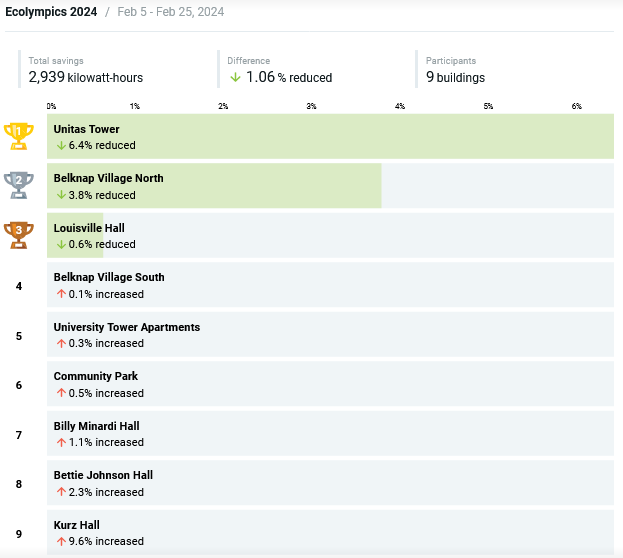 Congratulations went to residents of Unitas Tower for winning the Ecolympics Drawdown competition for the second year in a row!! Unitas residents reduced electricity use 6.4% from February 5-25, 2024. Second place went to Belknap Village North (3.8% reduction) and 3rd to Louisville Hall (0.6% reduction). Across all nine residence halls, students saved 2,939 kWh (1.1%) of electricity, or the carbon emissions from 1,665 average U.S. homes each year, according to the EPA Greenhouse Gas Emissions Calculator! Ride the wave of conservation – continue to unplug, turn off, take stairs, line dry clothes, do laundry in cold water, etc.
Congratulations went to residents of Unitas Tower for winning the Ecolympics Drawdown competition for the second year in a row!! Unitas residents reduced electricity use 6.4% from February 5-25, 2024. Second place went to Belknap Village North (3.8% reduction) and 3rd to Louisville Hall (0.6% reduction). Across all nine residence halls, students saved 2,939 kWh (1.1%) of electricity, or the carbon emissions from 1,665 average U.S. homes each year, according to the EPA Greenhouse Gas Emissions Calculator! Ride the wave of conservation – continue to unplug, turn off, take stairs, line dry clothes, do laundry in cold water, etc.
2023
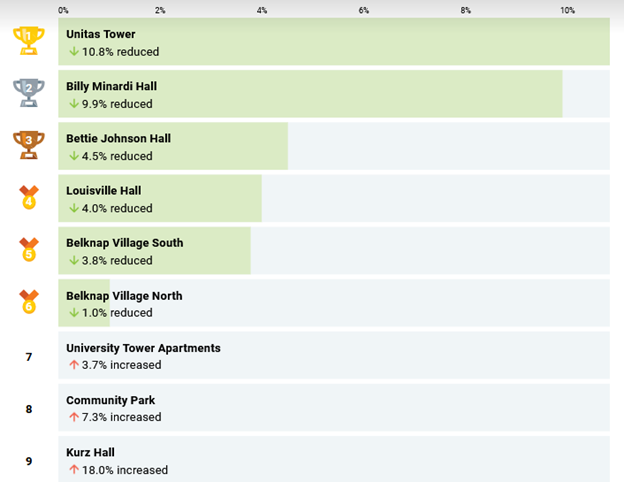 Congratulations to residents of Unitas Tower for winning the 2023 Ecolympics Drawdown competition by reducing electricity use by 10.8% from February 6-26! They won a house party sponsored by RHA!
Congratulations to residents of Unitas Tower for winning the 2023 Ecolympics Drawdown competition by reducing electricity use by 10.8% from February 6-26! They won a house party sponsored by RHA!
Honorable mention goes to the residents of other halls that were able to reduce their consumption over the three weeks competition: Billy Minardi (9.9%), Bettie Johnson (4.5%), Louisville Hall (4%), Belknap Village South (3.8%), and Belknap Village North (1%).
 2022
2022
All hail the residents of Bettie Johnson Hall who won the 2022 Dorm Drawdown by reducing their electricity use by 8% from February 7-27, 2022, as part of Ecolympics 2022!  They edged out Community Park (1.5% reduction) and Billy Minardi (0.6% reduction) to take the gold medal. A pizza party was held at Bettie Johnson Hall to celebrate the victory and thank residents for their actions to save energy.
They edged out Community Park (1.5% reduction) and Billy Minardi (0.6% reduction) to take the gold medal. A pizza party was held at Bettie Johnson Hall to celebrate the victory and thank residents for their actions to save energy.
Congrats to our 2022 Ecolympics Grand Prize Winner! Riding off into the sunset on our Grand Prize mountain bike is the amazing Adrian Dodd! Adrian is a Geography major who really increased their chances of winning by taking an amazing number and variety of green actions throughout the 8 week competition. Adrian’s sustainable actions included:
- Turning off lights when leaving or passing by an empty room (or just when the daylighting does the trick);
- Turning down the heat before bed so as to avoid burning fossil fuels unnecessarily;
- Walking to class without ever having to worry about parking, driving, and fueling a polluting car or e-scooter;
- Avoiding the landfill all together by recycling, reusing, and composting;
- Volunteering in the worm room at the UofL Community Composting project (every Sunday noon-2pm, just past Taco Bell on E. Bloom St.);
- Avoiding disposable cups by carrying a reusable/refillable cup;
- Carpooling with friends and new friends through Cardinal Directions; and
- Picking up litter while out rollerskating.
2021
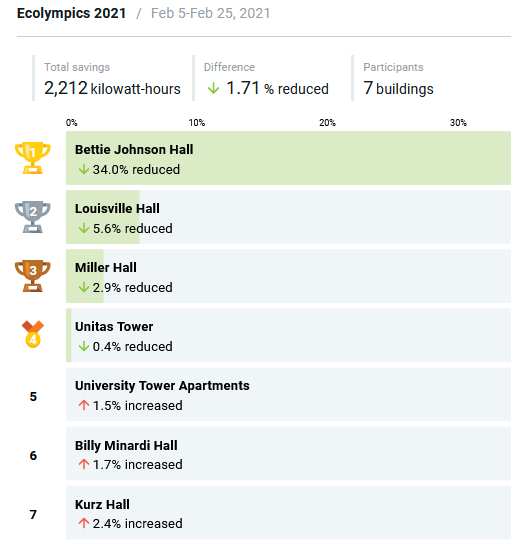 In the midst of Ecolympics 2021, we honored the students in all 7 residence halls for saving a total of 2,212 kilowatt-hours of electricity (1.71% reduction), despite a polar vortex, during our three-week Lockdown Drawdown! from February 5-25, 2021. That's equivalent to preventing the climate-altering greenhouse gas emissions from:
In the midst of Ecolympics 2021, we honored the students in all 7 residence halls for saving a total of 2,212 kilowatt-hours of electricity (1.71% reduction), despite a polar vortex, during our three-week Lockdown Drawdown! from February 5-25, 2021. That's equivalent to preventing the climate-altering greenhouse gas emissions from:
- 3,881 miles of driving an average car;
- Burning 176 gallons of gasoline;
- Burning 1,723 pounds of coal;
- Charging 199,457 smartphones; or
- The amount of carbon sequestered by 2 acres worth of U.S. forests in a year!
Our congratulations go out to Bettie Johnson Hall, which won 1st place by reducing their electricity consumption 34%!!! Louisville Hall finished 2nd with a 5.6% reduction; and Miller Hall claimed bronze with a 2.9% savings.
 Congratulations to all of our eight weekly Ecolympics 2021 winners who took an incredible variety of creative green actions throughout the Campus Race to Zero Waste: Leah Hazelwood, Anam Ahmed, Emily Nunez, Rebecca Eaton, Megan Cooper, Stacy Henley, Mimi Conti, and Megan E. Miller. Each one received a unique sustainability-themed prize pack! Our Grand Prize winner was Envirome Institute administrative assistant, Emily Coleman, who inspired all of us by sharing over 200 sustainable actions throughout the competition! She pedaled home on her prize: a slick, Cardinal-colored Dahon folding bicycle! All winners received an experiential prize on Earth Day 2021 - an insider's sustainability tour of UofL's LEED Gold Student Rec Center, including a climb up to the roof to check out the solar water heating system!
Congratulations to all of our eight weekly Ecolympics 2021 winners who took an incredible variety of creative green actions throughout the Campus Race to Zero Waste: Leah Hazelwood, Anam Ahmed, Emily Nunez, Rebecca Eaton, Megan Cooper, Stacy Henley, Mimi Conti, and Megan E. Miller. Each one received a unique sustainability-themed prize pack! Our Grand Prize winner was Envirome Institute administrative assistant, Emily Coleman, who inspired all of us by sharing over 200 sustainable actions throughout the competition! She pedaled home on her prize: a slick, Cardinal-colored Dahon folding bicycle! All winners received an experiential prize on Earth Day 2021 - an insider's sustainability tour of UofL's LEED Gold Student Rec Center, including a climb up to the roof to check out the solar water heating system!
2019
As part of Ecolympics 2019, Campus Housing and the UofL Sustainability Council hosted a dorm-based energy conservation competition from February 1-21, 2019. Due to poor promotion of the challenge to residents, electricity consumption actually increased by a total of 4.4% (12,005 kWh) across all eight residence halls in the competition. 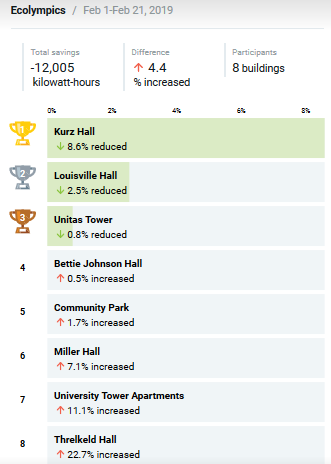 Thanks to the dedicated efforts by residents in three of the halls, however, some were able to reduce electricity consumption over the three weeks:
Thanks to the dedicated efforts by residents in three of the halls, however, some were able to reduce electricity consumption over the three weeks:
- Kurz Hall reduced 8.6%
- Louisville Hall reduced 2.5%
- Unitas Tower reduced 0.8%
- Bettie Johnson Hall increased 0.5%
- Community Park increased 1.7%
- Miller Hall increased 7.1%
- University Tower Apartments increased 11.1%
- Threlkeld Hall increased 22.7%
Congratulations to the residents of Kurz Hall for winning their first Gold Medal in Ecolympics!!
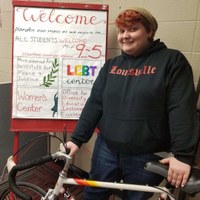 Congratulations to our Ecolympics GRAND PRIZE WINNER!
Congratulations to our Ecolympics GRAND PRIZE WINNER!
UofL student, Jesse Villier, was crowned the 2019 Ecolympics Challenge winner!
Jesse tagged @UofLsustainable throughout the competition on many different photos of various sustainable actions to earn the free bike. Thank you, everyone, for your participation and congratulations Jesse!
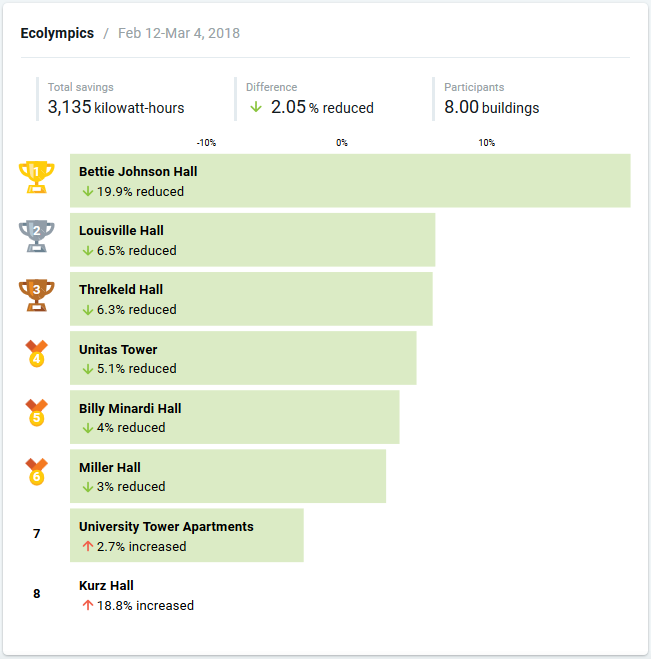 2018
2018
As a part of Ecolympics 2018, UofL competed in the Campus Conservation Nationals from February 11 to March 4, 2018. Thanks to the creative and dedicated conservation efforts of residents, electricity consumption dropped 2.05% across all eight residence halls in the competition. This represents a total savings of 3,135 kilowatt-hours of electricity. According to the EPA's Greenhouse Gas Equivalencies Calculator, this equates to:
- 2.3 tons of carbon emissions kept out of our atmosphere; or
- The emissions from driving an average car 5,718 miles; or
- The carbon pollution from burning 2,553 pounds of coal; or
- The emissions avoided by replacing 78 incandescent bulbs with LEDs; or
- The amount of carbon that 2.7 acres of forest in the U.S. pull out of the atmosphere each year.
All but two of the halls in the competition were able to reduce electricity consumption over the three weeks:
- Bettie Johnson Hall reduced 19.9%
- Louisville Hall reduced 6.5%
- Threlkeld Hall reduced 6.3%
- Unitas Tower reduced 5.1%
- Billy Minardi Hall reduced 4%
- Miller Hall reduced 3%
Congratulations to Bettie Johnson Hall for winning the Gold Medal in Ecolympics for the third year in a row!!
Individual Green Actions Winner (#ULEcolympics2018):
Congratulations to Mike Weber @its_miiikey, who won the Cardinal colored Echo by PureFix Cycles with fifteen #ULEcolympics2018 social media posts showing all the ways he is going green! See some of his video posts here.
2017
As a part of Ecolympics 2017, UofL competed in the Campus Conservation Nationals from February 13 to March 5, 2017. 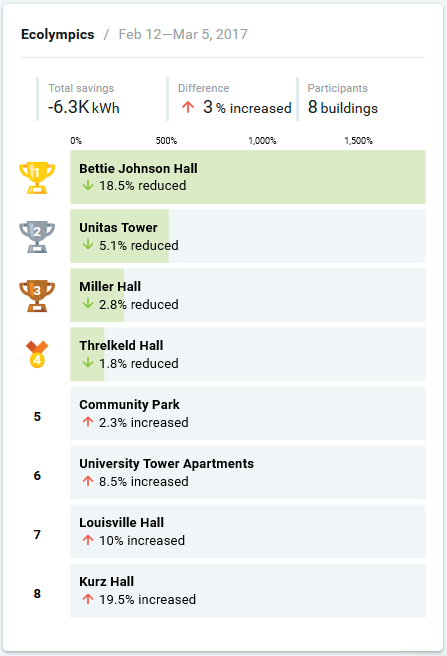 Out of the eight major residence halls on Belknap campus, four were able to reduce electricity consumption over the three weeks, thanks to the conservation efforts of residents:
Out of the eight major residence halls on Belknap campus, four were able to reduce electricity consumption over the three weeks, thanks to the conservation efforts of residents:
- Bettie Johnson Hall reduced 18.5%
- Unitas Tower reduced 5.1%
- Miller Hall reduced 2.8%
- Threlkeld Hall reduced 1.8%
Congratulations to Bettie Johnson Hall for being the winning on-campus hall for two years running!
Individual Green Actions Winners (#ULEcolympics2017):
1st: Andrew Walz (video)
2nd: Rakesh Gadde
3rd: Adelaide McComb and Riyaz Jiwani *tie
2016
The results of the Ecolympics 2016 - Cards Cutting Carbon - Feb. 15 to March 6, 2016 competition exceeded all expectations! For the first year ever, all nine participating housing facilities managed to reduce their electricity usage at least somewhat! The two winning halls were The Clubhouse and Bettie Johnson Hall, with reductions of 50.3% and 27.5%, respectively. Over the three weeks, residents helped save 151,882 kWh which equates to keeping 314,696 pounds of carbon dioxide out of the atmosphere, and saving $13,487 in utility bills!
Congratulations to all our residents, especially our winners:
-
 For being the UofL hall to reduce the most, Bettie Johnson Hall (27.5% savings) received a Green Renovation prize of a brand new PowerSol umbrella - a solar charging station for mobile devices located at a common table in the courtyard. Features include:
For being the UofL hall to reduce the most, Bettie Johnson Hall (27.5% savings) received a Green Renovation prize of a brand new PowerSol umbrella - a solar charging station for mobile devices located at a common table in the courtyard. Features include:
- Solar-powered mobile device charging as fast as a wall outlet, day or night.
- Three weather-proofed USB ports charge up to three mobile devices simultaneously.
- Commercial-grade patio umbrella protects users from harmful UV rays.
- Intelligent sensing acknowledges when mobile device is fully charged.
- LED display indicates how much solar energy is currently stored for charging needs. - Our Grand Prize winner for being most active resident in Ecolympics 2016, Alexander Levesque of Miller Hall, won a $400 shopping spree at a local bike shop! Congratulations, Alexander!
2015
UofL residents battled it out to reduce energy use during the 2015 Campus Conservation Nationals February 9th to March 1st. Each year since 2012, UofL has competed nationally (and locally in the Bluegrass Unplugged competition against UK, WKU, and Berea) to reduce electricity use in residence halls during the Campus Conservation Nationals.CCN is the largest nationwide electricity and water reduction competition on over 100 college and university campuses, covering thousands of buildings and hundreds of thousands of students!Congratulations to our winners!
- Threlkeld Hall finished first with an overall 2.3% reduction in electricity use, followed by UTA with a 1.1% reduction. As grand champions, the residents of Threlkeld received a special in-house dinner catered by Mark's Feed Store on April 16th. During the meal, residents brainstormed possible projects to be part of their Green Renovation award. Thanks to the resident's energy-conscious actions, over the summer of 2015, the Threlkeld lobby got a brand new water bottle filling station and bikeshare system.
- Our top 2015 Conservation Superheroes were: Benjamin Leamon (UTA), Gerald Leslie (Kurz), Abby Chen (Louisville Hall), John Hinely (Threlkeld), Hanna Sullivan & Alyssa Farley (Bettie Johnson), and Connor Priest (Miller). All were invited to a special Dinner with President Ramsey on April 6, 2015.
- The highest individual performer throughout the competition was Benjamin Leamon (UTA), who racked up an impressive total of 317 points for a wide variety of sustainability actions recorded on myActions.org. For his efforts, Benjamin won a brand new commuter bike!
- The top 2 RAs through myActions.org were Abby Chen from Louisville Hall and Connor Priest from Miller Hall.
The competition has ended, but the need to stop wasting energy hasn’t! UofL encourages residents to keep up the conservation momentum: turn off lights/TVs/computers; take the stairs; unplug things; dry clothes on a rack; shower with solar power at the SRC; etc. Log your actions for sustainability at myActions.org.
2014
-
Final 2014 Rankings by Residence Hall (% reduction in energy use February 10 to March 2, 2014):

- Threlkeld Hall (8.7% reduction)
- Cardinal Towne (6.5% reduction)
- Kurz Hall(real-time data!) (5.8% reduction)
- Louisville Hall(real-time data!) (5.3% reduction)
- Billy Minardi Hall (4.9% reduction)
- Unitas Hall(real-time data!) (3.0% reduction)
- The Complex (West, Center & Wellness) (2.4% reduction)
- University Tower Apartments (UTA) (0.8% reduction)
- Community Park(real-time data!) (0.4% reduction)
- Miller Hall (0.7% INCREASE)
- Bettie Johnson Hall (43.1% INCREASE)
- In 2014, UofL residents were able to reduce energy consumption by 2.9% overall! Residents saved 8003 kWh of electricity, worth about $400. This equates to keeping 5.5 metric tons (12,161 pounds) of carbon dioxide pollution out of the atmosphere. That's equivalent to annual emissions from: driving 13,134 miles, switching 144 incandescent bulbs to CFLs, or half of the average home’s energy use!
-
Prizes were awarded to the UofL residence hall which reduced the most! Threlkeld Hall led the way with an 8.7% reduction, earning the Grand Prize: a Skate Party at Skate World on March 5th and a Green Renovation project chosen by the residents for their hall! The sustainable improvements included:
- The flooring in the lobby was changed from carpet to a luxury vinyl tile. Not only is the tile better looking, but it is also a longer-wearing product that requires only water to clean – no chemicals or other harsh products.
- All of the old, inefficient washing machines were with newer, more efficient models.
- Leaky showerheads were replaced throughout the building. Although the existing showerheads were low-flow fixtures, they frequently leaked and were replaced with a more durable low-flow fixture.
- The worn furniture in the common area was replaced with a product that uses a sustainable fabric and is designed to be modular so that, if a part of a chair is broken, we can replace just that part easily rather than having to dispose of the entire chair.
- Individual 2014 Conservation Heroes were also entered in two prize raffles after pledging to conserve or by posting photos of their green efforts on Facebook. One resident earned a $400 bike shopping spree and five others earned a Dinner with Provost Willihnganz. During the competition, tables were set up in the lobby of one of the halls where residents could pledge to take action and pick up free UofL Sustainability reusable shoulder bags, t-shirts, mugs, and water bottles!
- Residents were encouraged to make a personal commitment to reduce and keep track of their hall's progress with UofL's Building Dashboard online portal!
- In addition to UofL, CCN 2014 involved 109 schools, 1330 buildings, and over 265,000 students & staff across North America. Together, we saved 2.2 million kWh! That's the equivalent of removing 201 homes from the grid for a year and keeping 3 million pounds of carbon dioxide pollution out of the atmosphere!
2013
- In 2013, UofL joined 120 colleges & universities across North America in engaging over 300,000 student residents to help save 2,114,844 kWh of electricity! That's equivalent to keeping 2,426,060 pounds of carbon pollution out of the air; saving $178,716; and taking 187 US homes off the grid for a year.
-
Final 2013 Rankings by Residence Hall (% reduction in energy use March 23 - April 12, 2013):
1. Bettie Johnson Hall (15%)
2. Billy Minardi Hall (8.2%)
3. The Complex (West, Center & Wellness Halls) (6.2%)
4. Miller Hall (3.2%)
5. Threlkeld Hall (2.3%)
6. Cardinal Towne (3.1% increase)
7. University Tower Apts (UTA) (3.3% increase)
8. Unitas Hall (real-time data!) (5.6% increase)
9. Louisville Hall (real-time data!) (7.2% increase)
10.Community Park (real-time data!) (16.7% increase)
11.Kurz Hall (real-time data!) (45.3% increase) - Read the story from UofL Green Scene: Students Compete to Reduce.
2012
- In 2012, UofL was one of 100 colleges & universities which engaged over 200,000 residents to save 1.7 gigawatt-hours of electricity! This equates to taking 151 U.S. homes off the grid for a year, $158,000 in savings, and 2.6 million pounds of carbon dioxide emissions averted!
- From March 26 - April 15, 2012 UofL residents were able to reduce energy consumption 11.9%, saving 38,415 kWh of electricity! This equates to $2,689 in savings, and 78,789 pounds of carbon dioxide averted!
-
Final 2012 Rankings by Residence Hall (% reduction in energy use):
1. University Tower Apartments (UTA) (36.4%)
2. Kurz Hall (real-time!) (20.5%)
3. Louisville Hall (real-time!) (12.2%)
4. Community Park (real-time!) (10.3%)
5. The Complex (West, Center & Wellness Halls) (8.0%)
6. Unitas Hall (real-time!) (4.5%)
7. Bettie Johnson Hall (1.2%)
8. Miller Hall (0.7%)
9. Threlkeld Hall (2.1% INCREASE) - As one of the top ten energy reducers in 2012, UofL earned 200 megawatt-hours of renewable energy credits (RECs) from Sterling Planet!
- Read the story from UofL Green Scene: Wrapping your mind around reducing campus energy use.
UofL earns award, top ranking for green efforts (UofL Today, August 17, 2012)
Imagine A University...
We take inspiration from Rocky Mountain Institute Chief Scientist Amory Lovins and participants in the 2012 Appalachian Energy Summit who ask us to imagine a university that...
- "Makes students, employees, and community members happier and healthier;
- Where campuses are used as part of the education curriculum, and smart, climate-responsive buildings teach students about integrative design and new technologies;
- Where facilities managers are seen not as overhead to be minimized but as profit centers to be maximized;
- Have energy courses as part of the general education requirements;
- Can participate in purchase power agreements with energy developers and are able to negotiate with utilities;
- Have non-siloed departments that work together to create and implement an energy plan and strategy;
- Have a common clean energy plan for all of the campuses in the state;
- Have aggressive metering and measuring for each building on campus;
- Reward students and staff for not having cars on campus;
- Have coordinated land use and transportation planning with local municipalities;
- Successfully train students to be the nation’s next energy leaders; and
- Have revolving loan funds to reinvest energy savings back into the school"
 Congratulations to residents of Unitas Tower for winning the 2023 Ecolympics Drawdown competition by reducing electricity use by 10.8% from February 6-26! They won a house party sponsored by RHA!
Congratulations to residents of Unitas Tower for winning the 2023 Ecolympics Drawdown competition by reducing electricity use by 10.8% from February 6-26! They won a house party sponsored by RHA!
Honorable mention goes to the residents of other halls that were able to reduce their consumption over the three weeks competition: Billy Minardi (9.9%), Bettie Johnson (4.5%), Louisville Hall (4%), Belknap Village South (3.8%), and Belknap Village North (1%).





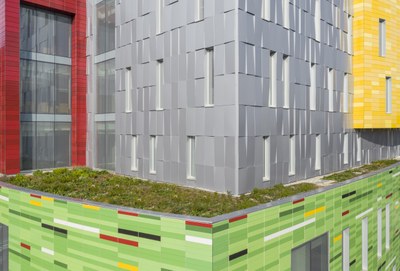


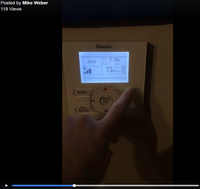 Ecolympics 2018 Winner Mike Weber turns it off!
Ecolympics 2018 Winner Mike Weber turns it off!

